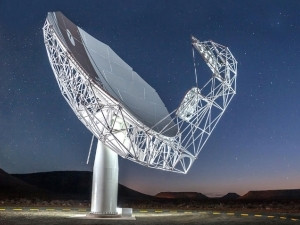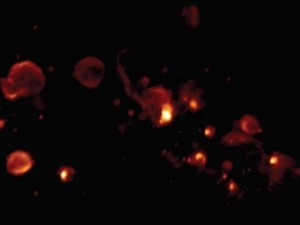
The Square Kilometre Array (SKA) SA yesterday presented the first Array Release 1.5 images taken with MeerKAT 32 to science and technology minister Naledi Pandor.
This was before the minister delivered the Budget Vote of the Department of Science and Technology in Parliament. Pandor embarked on a tour of the exhibition at the Iziko Museum, where SKA SA joined other exhibitors for the showcase.
Later on in her Budget Vote, Pandor allocated R693 million to the SKA to ensure the completion of the MeerKAT - the SKA's demonstrator project.
The MeerKAT radio telescope is the precursor of phase one of the SKA. SKA will be built in two main phases, with construction of the first phase planned to start in 2017/18 and some elements operational by 2020 and full operation under way in 2025.
The SKA project is an international effort to build the world's largest radio telescope to be hosted in SA and Australia. SA's Karoo desert in the Northern Cape will host the core of the mid-frequency dish array, ultimately extending over the African continent.
Eventually, the SKA will be made up of thousands of dishes that will enable astronomers to survey the universe in detail and survey the entire sky much faster, and in more detail, than any system currently in existence.
Milestone achievements
During the minister's visit to the exhibition, SKA SA chief scientist Dr Fernando Camilo and SKA SA head of science commissioning Dr Sharmila Goedhart released the recent AR1.5 results, images achieved by using various configurations of the 32 antennas currently operational in the Karoo.
This milestone of the integration of 32 antennas with single polarisation correlator was achieved on schedule by the end of March 2017. The 32 antennas are part of the eventual 64 instruments which are being built at the Losberg site in the Northern Cape.

Camilo and Goedhart presented the view of the hydrogen gas in M83, a famous galaxy discovered in the Cape of Good Hope in 1752, generated by MeerKAT. The image was done with the MeerKAT configuration using seven 50-minute exposures - achieving this detail and sensitivity much faster than any previous observations, says SKA.
The scientists also showcased a linear feature - a radio galaxy - that is four million light years long, identifying it as a Giant Radio Galaxy, the first such extreme object identified by MeerKAT.
A star-forming region in the Milky Way was also presented. The previous best image of this star-forming region was obtained with the Australia Telescope Compact Array. The MeerKAT image is sharper and more sensitive; and shows fainter features with additional detail.
The SKA also displayed the increased observation power of MeerKAT through demonstrating the images taken with KAT-7 in 2012, MeerKAT-4 in 2016, MeerKAT-16 in 2016 and MeerKAT-16 in 2017. The same black hole was observed with the increasingly improved arrays of antennas.
Also showcased was the first radio image of a distant spiral galaxy, showing both the visible light and the radio waves which left this galaxy 230 million years ago.
Local benefits
The SKA will be the world's largest and most sensitive radio telescope, Pandor said. "Key economic benefits from this investment will be the leveraging of foreign direct investment from the SKA Organisation for construction costs of phase one of SKA."
She noted that on Africa Day, 25 May, SA will mark five years since the country was named as co-host of the SKA.
"I'm pleased to report that we now have 45 antennas and 57 pedestals installed as part of MeerKAT and we are on track to build the full complement of 64 by 31 March 2018. MeerKAT has reached another milestone with the integration of the 32 antennas into a polarisation correlator or array. The next array release, AR2, is set for later this year."
Furthermore, Pandor said, 75% of MeerKAT components have been sourced locally. "To date, MeerKAT has spent R134 million on local construction suppliers, and 351 people have been trained by major SKA contractors such as Stratcom. The SKA project has created 7 284 employment opportunities through the construction of the KAT-7, MeerKAT and related projects.
"In its 11th year, the SKA bursary initiative has funded 919 students, 133 of whom are from other African countries. The department continues to provide extensive support to schools in Carnarvon. Nine learners from Carnarvon High School have received full-cost undergraduate bursaries. We look forward to the beginning of SKA phase one construction between 2018 and 2022."
Share